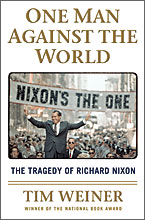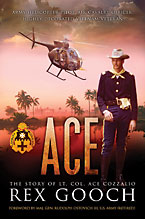 |
||||||||||||
|
Books in Review, September/October 2015 One Man Against the World: President Nixon and the War BY REVIEWS BY MARC LEEPSON AND JAMES P. COAN
Weiner, who won a National Book Award for Legacy of Ashes, a history of the CIA, and a Pulitzer for his reporting at The New York Times, offers a damning look at the Nixon presidency in this well-researched and powerfully written tome. In his analysis, Weiner concentrates on what he calls “the intertwined issues of war and national security.” Why focus on that? Because, Weiner explains, “Nixon spent so many of his hours and so much of his power wrestling with those twin demons.” The number one issue Nixon faced when he took office in January 1969 was the conflict that he inherited in Vietnam. Weiner goes deeply into that aspect of the Nixon presidency in this book. In doing so, he leans heavily on mountains of recently (2007-14) declassified documents, including hundreds of hours of White House tapes and Nixon Chief of Staff H.R. Haldeman’s personal diary. Weiner finds much to condemn in the way President Nixon prosecuted the war in Vietnam. It started even before Nixon became president. During the 1968 presidential campaign, Nixon, as Weiner notes, “pledged a program for peace without saying what his plan might be.” Weiner goes on to confirm what Ken Hughes uncovered in his recent book Chasing Shadows: The Nixon Tapes, the Chennault Affair, and the Origins of Watergate: that Nixon, in cahoots with Anna Chan Chennault and South Vietnam’s U.S. Ambassador Bui Diem, secretly and successfully undermined the Paris Peace Accords in the spring and summer of 1968. “This is treason,” President Lyndon Johnson said when he found out what Nixon (and his foreign-policy confidante Henry Kissinger) was up to. If “not treason,” Weiner adds, “it was a federal crime for a citizen to conduct private diplomacy with a foreign government against the interests of the United States.” Nixon secretly scuttling the peace talks for political gain prolonged the Vietnam War. But that’s just the start of a damning bill of Vietnam War policymaking particulars that Weiner lays on Nixon and Kissinger, his right-hand national security man. One example: the May 1970 invasion of Cambodia (largely a Kissinger production), which took the war into the supposedly neutral country for the first time. It escalated the war, did pitifully little to halt enemy activity in Cambodia, led directly to the rise of the murderous Khmer Rouge communist guerrillas, and rekindled the antiwar movement at home. The Cambodian incursion “was an unmitigated disaster,” a recently declassified National Security Agency history noted. Nixon, Weiner says, was “delusional on the subject.” His “disturbing opinions were shared by few if any American soldiers or spies. He thought the invasion a triumph of presidential power that would demoralize the enemy, destroy a potential communist attack on Saigon, shore up morale among American troops, and turn the tide of the whole war.” Nixon told Kissinger in October of 1970, Weiner says, “that it would prove the decisive battle, the bold decision that would lead to an imminent American victory in Vietnam.” Instead, American participation in the war dragged on for nearly three more years before a peace treaty was signed and the last U.S. combat troops withdrew. Two years later, in 1975, the Vietnamese communists took over the entire country. By that time, Nixon had resigned in disgrace during the Watergate affair. That’s another story—one that Weiner weaves into his narrative beginning in May of 1970 with the leak of the Pentagon Papers to The New York Times, and picking up steam in the summer of 1972 with the break-in by White House operatives at the Democratic National Committee headquarters in the Watergate. Watergate led to Nixon’s resignation in August 1974. Eight months later the war finally ended, although not in the way that Nixon and Kissinger had predicted.—M.L.
During his eighteen months in Vietnam, Allen “Ace” Cozzalio was shot down six times. On several other occasions he brought his Loach back home so damaged that it was no longer flyable. He received every medal for valor except the Medal of Honor. As a newly arrived 2nd Lt. in December of 1967, Cozzalio was assigned to D Troop, 3rd Squadron, 5th Cavalry, attached to the 9th Infantry Division as its recon unit. The squadron called itself the “Bastard Cav” because it was a stand-alone cavalry unit attached to an infantry division. The image of a rogue, renegade rebel appealed to the D Troopers; it was a perfect match for Ace Cozzalio. Soon after he arrived, the unit began wearing yellow scarves and white Stetsons; some officers carried sabers. Ace Cozzalio donned a full 1860s cavalry uniform at Lighthorse award ceremonies and other special occasions. Among his legendary exploits, Cozzalio, after seeing a Huey crash and explode in flames, landed his OH-6 Loach nearby and he and his crew chief rescued the unconscious pilot and co-pilot. Cozzalio and his crew chief received the Soldier’s Medal for their actions that day. On another occasion he landed the Loach on a canal berm where he had spotted an armed male tossing his weapon aside and jumping into the canal. Cozzalio donned his cavalry hat, grabbed his trusty saber, then jumped into the canal. He began poking around in the murky water until his blade found flesh and he took the VC prisoner—likely the only enemy soldier in the war captured with a cavalry saber. Following the 9th Infantry Division’s Battle of Phu My, Cozzalio was awarded the Distinguished Service Cross for performing an incredible act of bravery: Seeing a ninety-man unit pinned down by NVA machine-gun fire from a reinforced bunker, he landed his Loach on top of the bunker while his gunner jumped out and tossed a grenade into it. Cozzalio lifted off just before the grenade exploded and destroyed the bunker. After twenty years of service, Lt. Col. Cozzalio was discharged from the Army due to heart trouble caused by the rare Epstein-Barr virus. Seven years later, while undergoing a heart transplant procedure, he died at the age of 46. VVA member Rex Gooch has written a fast-moving and fascinating account of a legendary helicopter pilot who died much too soon, and of the others he flew alongside in the Mekong Delta. This book belongs on the bookshelf of any veteran, pilot or passenger, who experienced flying in a helicopter in Vietnam. —J.P.C.
|
||||||||||||
|
|
||||||||||||
|
||||||||||||
8719 Colesville Road, Suite 100, Silver Spring. MD 20910 | www.vva.org | contact us |
||||||||||||



















